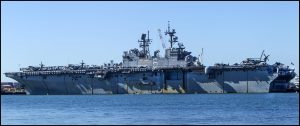In July, the amphibious assault ship Bonhomme Richard burned in a San Diego shipyard for almost five days. After an extensive evaluation of the ship and repair options, the U.S. Navy announced this week that it will decommission the ship.
The fire took hundreds of sailors and firefighters, dozens of trucks, and helicopters dumping water from the air to extinguish. Fire destroyed almost 60 percent of the ship’s interior and prolonged heat exceeding 649 degrees Celsius is believed to have compromised the ship’s steel structure.
According to the navy’s statement, restoring the ship to its former capability would cost more than $3 billion and could take seven years to complete. That is nearly as much as it would cost to build a new America-class amphibious assault ship and would tie up scarce shipyard facilities for years.
Other options considered were to repurpose the Bonhomme Richard into a different type of vessel, such as a submarine repair tender, hospital ship, or command ship. These options would all cost more than $1 billion and were determined to be more costly than to design and purpose-build one of those vessels from scratch.
As a Navy official told USNI News, “In the end, the decommissioning decision had a number of factors, and one of which was, what would be the impact of the dollars spent and the actual effort to rebuild, what would be the impact on the industrial base? The dollars definitely would disrupt our strategy for investment. And then from an industrial base perspective, we had concerns that it would impact new construction or other repair work, and we knew that Gulf Coast would be the spot to get the building or the restoration done because of the capacity and their capabilities – but in the end made the decision for multiple factors, as I mentioned, that decommissioning would be the way to go.”
Decommissioning and scrapping the ship will cost about $30 million and could take almost a year to complete.
Initially thought to be an industrial accident, the navy is reported to suspect that the fire was caused by arson committed by a sailor. That investigation is ongoing.
The Bonhomme Richard had recently received nearly $250 million in upgrades to accommodate the short-takeoff version of the F-35 fighter jet, essentially turning the more than 36 million kilogram ship into a small aircraft carrier.
Incorporating light carriers with the navy’s massive nuclear-powered super carriers is a major feature of the future navy plan unveiled by then Secretary of Defense Mark Esper in the fall, not long before he was fired by President Donald Trump. While that plan faces major industrial and funding hurdles, the navy had already modified four of its large amphibious assault ships to provide a light carrier capability and has contracted the conversion of a fifth.
With the loss of Bonhomme Richard and the fighters it would have carried, the navy now faces a significant shortfall in the combat power it anticipated being able to project into the Pacific to deter China’s huge, and still growing, fleet. With plans for building and deploying a new fleet of light carriers still mostly on paper, it is a gap that will take years to fill, if it ever is.

































